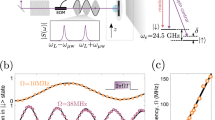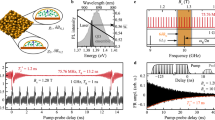Abstract
Quantum information processing requires accurate coherent control of quantum-mechanical two-level systems, but is hampered in practice by their coupling to an uncontrolled environment. For electron spins in III–V quantum dots, the random environment is mostly given by the nuclear spins in the quantum-dot host material; they collectively act on the electron spin through the hyperfine interaction, much like a random magnetic field. Here we show that the same hyperfine interaction can be harnessed such that partial control of the normally uncontrolled environment becomes possible. In particular, we observe that the electron-spin-resonance frequency remains locked to the frequency of an applied microwave magnetic field, even when the external magnetic field or the excitation frequency are changed. The nuclear field thereby adjusts itself such that the electron-spin-resonance condition remains satisfied. General theoretical arguments indicate that this spin-resonance locking might be accompanied by a significant reduction of the randomness in the nuclear field.
This is a preview of subscription content, access via your institution
Access options
Subscribe to this journal
Receive 12 print issues and online access
$209.00 per year
only $17.42 per issue
Buy this article
- Purchase on Springer Link
- Instant access to full article PDF
Prices may be subject to local taxes which are calculated during checkout





Similar content being viewed by others
References
Hanson, R., Kouwenhoven, L. P., Petta, J. R., Tarucha, S. & Vandersypen, L. M. K. Spins in few-electron quantum dots. Rev. Mod. Phys. 79, 1217–1265 (2007).
Khaetskii, A. V., Loss, D. & Glazman, L. Electron spin decoherence in quantum dots due to interaction with nuclei. Phys. Rev. Lett. 88, 186802 (2002).
Merkulov, I. A., Efros, Al. L. & Rosen, M. Electron spin relaxation by nuclei in semiconductor quantum dots. Phys. Rev. B 65, 205309 (2002).
Petta, J. R. et al. Coherent manipulation of coupled electron spins in semiconductor quantum dots. Science 309, 2180–2184 (2005).
Koppens, F. H. L., Nowack, K. C. & Vandersypen, L. M. K. Spin echo of a single electron spin in a quantum dot. Phys. Rev. Lett. 100, 236802 (2008).
Greilich, A. et al. Mode locking of electron spin coherences in singly charged quantum dots. Science 313, 341–345 (2006).
Koppens, F. H. L. et al. Driven coherent oscillations of a single electron spin in a quantum dot. Nature 442, 766–771 (2006).
Burkard, G., Loss, D. & DiVincenzo, D. P. Coupled quantum dots as quantum gates. Phys. Rev. B 59, 2070–2078 (1999).
Klauser, D., Coish, W. A. & Loss, D. Nuclear spin state narrowing via gate-controlled Rabi oscillations in a double quantum dot. Phys. Rev. B 73, 205302 (2006).
Giedke, G., Taylor, J. M., D’Alessandro, D., Lukin, M. D. & Imamoğlu, A. Quantum measurement of a mesoscopic spin ensemble. Phys. Rev. A 74, 032316 (2006).
Stepanenko, D., Burkard, G., Giedke, G. & Imamoğlu, A. Enhancement of electron spin coherence by optical preparation of nuclear spins. Phys. Rev. Lett. 96, 136401 (2006).
Coish, W. A. & Loss, D. Hyperfine interaction in a quantum dot: Non-Markovian electron spin dynamics. Phys. Rev. B 70, 195340 (2004).
Witzel, W. M. & Das Sarma, S. Quantum theory for electron spin decoherence induced by nuclear spin dynamics in semiconductor quantum computer architectures: Spectral diffusion of localized electron spins in the nuclear solid-state environment. Phys. Rev. B 74, 035322 (2006).
Greilich, A. et al. Collective single mode precession of electron spins in a quantum dot ensemble. Phys. Rev. B 79, 201305(R) (2009).
Reilly, D. J. et al. Suppressing spin qubit dephasing by nuclear state preparation. Science 321, 817–821 (2008).
Ono, K. & Tarucha, S. Nuclear-spin-induced oscillatory current in spin-blockaded quantum dots. Phys. Rev. Lett. 92, 256803 (2004).
Koppens, F. H. L. et al. Control and detection of singlet–triplet mixing in a random nuclear field. Science 309, 1346–1350 (2005).
Reilly, D. J. et al. Measurement of temporal correlations of the Overhauser field in a double quantum dot. Phys. Rev. Lett. 101, 236803 (2008).
Foletti, S. et al. Dynamic nuclear polarization using a single pair of electrons. Preprint at <http://arxiv.org/abs/0801.3613> (2008).
Baugh, J., Kitamura, Y., Ono, K. & Tarucha, S. Large nuclear Overhauser fields detected in vertically coupled double quantum dots. Phys. Rev. Lett. 99, 096804 (2007).
Tartakovskii, A. I. et al. Nuclear spin switch in semiconductor quantum dots. Phys. Rev. Lett. 98, 026806 (2007).
Braun, P.-F. et al. Bistability of the nuclear polarization created through optical pumping in In1−xGaxAs quantum dots. Phys. Rev. B 74, 245306 (2006).
Maletinsky, P., Lai, C. W., Badolato, A. & Imamoğlu, A. Nonlinear dynamics of quantum dot nuclear spins. Phys. Rev. B 75, 035409 (2007).
Ono, K., Austing, D. G., Tokura, Y. & Tarucha, S. Current rectification by Pauli exclusion in a weakly coupled double quantum dot system. Science 297, 1313–1317 (2002).
Koppens, F. H. L. et al. Detection of single electron spin resonance in a double quantum dot. J. Appl. Phys. 101, 081706 (2007).
Danon, J. et al. Multiple nuclear polarization states in a double quantum dot. Phys. Rev. Lett. 103, 046601 (2009).
Danon, J. & Nazarov, Yu. V. Nuclear tuning and detuning of the electron spin resonance in a quantum dot: Theoretical consideration. Phys. Rev. Lett. 100, 056603 (2008).
Rudner, M. S. & Levitov, L. S. Electrically driven reverse Overhauser pumping of nuclear spins in quantum dots. Phys. Rev. Lett. 99, 246602 (2007).
Laird, E. A. et al. Hyperfine-mediated gate-driven electron spin resonance. Phys. Rev. Lett. 99, 246601 (2007).
Acknowledgements
We thank F. R. Braakman, P. C. de Groot, R. Hanson, M. Laforest, L. R. Schreiber, G. A. Steele and S.-C. Wang for help and discussions, and R. Schouten, A. van der Enden, R. G. Roeleveld and P. van Oossanen for technical support. This work is supported by the ‘Stichting voor Fundamenteel Onderzoek der Materie (FOM)’ and the ‘Nederlandse Organisatie voor Wetenschappelijk Onderzoek (NWO)’.
Author information
Authors and Affiliations
Contributions
I.T.V., K.C.N and F.H.L.K. performed the experiment, I.T.V., K.C.N., F.H.L.K. and L.M.K.V were responsible for the project planning, J.D. and Y.V.N. developed the theory, all authors contributed to the interpretation of the data and I.T.V., K.C.N, J.D. and L.M.K.V wrote the manuscript.
Corresponding author
Supplementary information
Supplementary Information
Supplementary Information (PDF 442 kb)
Rights and permissions
About this article
Cite this article
Vink, I., Nowack, K., Koppens, F. et al. Locking electron spins into magnetic resonance by electron–nuclear feedback. Nature Phys 5, 764–768 (2009). https://doi.org/10.1038/nphys1366
Received:
Accepted:
Published:
Issue Date:
DOI: https://doi.org/10.1038/nphys1366
This article is cited by
-
Quantum sensing of a coherent single spin excitation in a nuclear ensemble
Nature Physics (2021)
-
Witnessing quantum correlations in a nuclear ensemble via an electron spin qubit
Nature Physics (2021)
-
Pulse control protocols for preserving coherence in dipolar-coupled nuclear spin baths
Nature Communications (2019)
-
Discretization of the total magnetic field by the nuclear spin bath in fluorine-doped ZnSe
Nature Communications (2018)
-
Strongly polarizing weakly coupled 13C nuclear spins with optically pumped nitrogen-vacancy center
Scientific Reports (2015)



